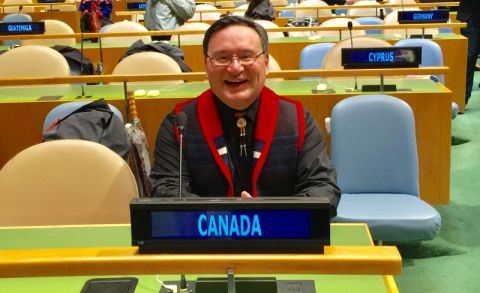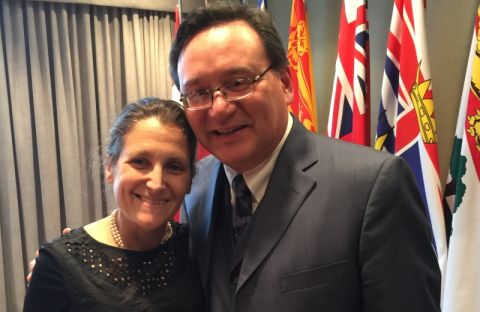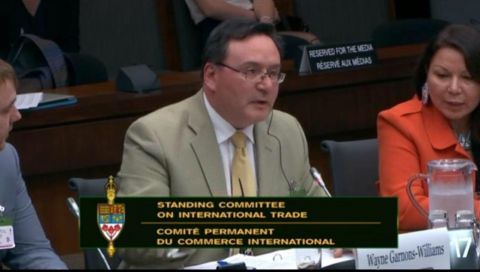


On December 10, Canada took a major step toward a more inclusive and prosperous economy that protects Indigenous peoples' rights and the environment. The country endorsed the Indigenous Peoples Economic and Trade Cooperation Arrangement (IPETCA). Wayne Garnons-Williams, Law’90, played a key role as Canada’s Indigenous lead in negotiating this unique agreement. Once officially implemented, it will bring to the forefront the nexus of Indigenous philosophy, economics, trade, and environmental stewardship.
“This agreement is completely different from previous trade agreements, which focused on the economy, corporate prosperity, and general economic development for the nation,” says Garnons-Williams. “While IPETCA focuses on those factors, it also has an overlaying of Indigenous rights-based concepts.”
In addition, as the first trade agreement of its kind, IPECTA saw Indigenous peoples negotiating alongside their nation’s trade representatives for each of the participating nation states: Canada, New Zealand, Australia, and Taiwan. As observer states, the U.S., Peru, Chile, and others with Indigenous populations are also looking at this trade opportunity.
For Indigenous people, business and economic growth are inexplicably tied to protecting the environment and ecosystem, and maintaining a balance. “That means you only take what you need with respect to using nature as opposed to the Keynesian and Adam Smith models of reaping as much as you can from resources to maximize profit,” he explains. “From an Indigenous perspective, you respect the seventh-generation principle, which is not to adversely affect the rights and entitlements of the future generation that you will never know. That’s the kind of philosophy that Indigenous trade is bringing to the forefront when we talk about a rights-based Indigenous trade, nation-state to nation-state agreement.”
IPETCA does this through various sections that emphasize the upholding of Indigenous values, the philosophy of Indigenous sustainable development, and respect for the current international tools to protect the environment. That starts with the first-ever definition of “Indigenous trade and investment,” which includes “forms of trade and investment with, between, and among, Indigenous peoples from the participating economies. Indigenous trade and investment may be constituted in elements that include...the responsibility of Indigenous peoples to protect their lands, resources, and the spiritual interrelationship of the human and natural world, as well as the integrity of the natural systems themselves...”
“That definition is powerful, and is needed in this day and age, when we’ve got a climate crisis on our hands,” says Garnons-Williams. “Indigenous people can lead the way in demonstrating best practices in environmental stewardship and successful trade.”
Many clauses throughout the Agreement clearly demonstrate respect for Indigenous environmental undertakings, he adds, and they made sure certain clauses were put in to recognize the “need to strengthen the knowledge, technologies, practices, and efforts of Indigenous peoples related to addressing and the protection of endangered species, biodiversity loss, and climate change” in existing international agreements. These agreements include the UN Framework Convention on Climate Change, the Paris Agreement, the Convention on Biological Diversity, the UN Convention to Combat Desertification, and the Convention on the International Trade in Endangered Species. “All of those are really good tools that we want to uphold moving forward,” he says.
IPECTA also highlights the importance of achieving the UN Sustainable Development Goals, “given their relevance to Indigenous peoples, including how they relate to the protection of lands, waters, and natural resources, and how they support the conditions for sustainable and inclusive economic development.” Garnons-Williams says, “The overarching theme is that we want trade that doesn’t adversely impact the ecosystems. We need to set that as the high-water mark for developing Indigenous systems.”
With no other Indigenous trade systems internationally, he says, IPECTA is a new model from which Indigenous people can create anything from their own supply chains to Indigenous foreign trade zones. That’s part of section 4: “…The participating economies will, individually and collectively...promote international trade policies and Indigenous policies that are mutually supportive in order to...further Indigenous peoples’ worldviews regarding the sustainable management of natural resources, in order to advance economic development.” That clause not only makes clear the obligation to be more environmentally responsible, but also upholds Indigenous legal theories and principles for sustainable development and environmental stewardship.
What Garnons-Williams calls the “icing on the cake” is the first conference on Indigenous economics hosted by the Bank of Canada with the national bank governors of New Zealand, Australia, and the U.S. on November 29 and 30. “The governors admitted that their nations can do a lot better and that they need to learn from Indigenous well-being and how to be more inclusive and respectful of Indigenous perspectives in economic development in fostering finance tools,” he states. “What they say matters and sends a ripple through the economy.” Their speeches also tie into the IPECTA clause that “…The participating economies will cooperate domestically, regionally, and internationally to support policies and programmes, and to carry out activities that may include... promoting and facilitating access to capital and markets, including export financing, and domestic and global investment opportunities to assist Indigenous entrepreneurs and business owners to foster and enhance trade and investment…”
At the conference, the governor of New Zealand’s national bank discussed how his country is changing the way it measures gross domestic product (GDP) to focus not just on profit, but also on societal well-being of individuals. As Garnons-Williams puts it, “The minister of finance of New Zealand took a page from the Māori philosophy of well-being, and part of that is what people appreciate. What they appreciate is green space, breathable air, drinkable water, and sustainable forests, so they get valued now – and what gets measured and valued has value to protect.”
With well-being included in New Zealand’s GDP measurement, all four countries represented at the national bank conference having joined Indigenous partners to form the Central Bank Network for Indigenous Inclusion (Canada having been the first), and IPECTA itself, Garnons-Williams says change is beginning. “We can see that there’s a receptivity coming to other nation states to re-tweak how we value our economy. Given the fact that we are dealing with a climate crisis, we see the mechanisms of government starting to shift and listen a little bit more to Indigenous philosophies that are focused on well-being of the ecosystem in relationship to the well-being of the individual.”
What also makes IPECTA unique was its multi-layered negotiation process. Garnons-Williams and other members of Canada’s Indigenous Peoples Advisory Committee would first discuss each clause with Government of Canada trade representatives. Then he would meet separately via Zoom with the Indigenous leads in New Zealand, Australia, and Taiwan, and with observer Indigenous peoples to discuss and find better understandings that they could take back to their respective nation-state representatives. “That really made a difference from a procedural standpoint, because a lot of the gamesmanship of the old method of negotiating got thrown out the window,” he says.
Instead of playing cards close to the chest, showing a draft, and asking the other party what they thought about it, they asked questions about underlying factors. These questions included what motivated a clause, what industry were they trying to protect, were there political, economic, or cultural concerns, and why were certain clauses important. Then they worked on mutually agreeable solutions that they could present to their respective nation-state representatives.
Another benefit of this negotiation process was forming professional relationships with Indigenous experts from each nation state. “The Indigenous people who negotiated the Agreement are going to be trying to develop it with their respective Indigenous companies and nation-state people,” he explains. “We’ve already got a really good working relationship with these business and political leaders. That’s going to aid in bringing this Agreement to life and really help things move along smoothly.”
While there are different cultural needs to be respected and political constraints, Garnons-Williams says he thinks frank discussions can more easily be had with Indigenous nation representatives because they share a different philosophy in progressing IPECTA. “We want to make sure that the greater good happens, not just that my nation state has the advantage,” he says. “How we can make sure that the environment is protected and that everyone gets a fair shake are two of the most important things in the document moving forward. Fairness, transparency, and environmental stewardship – that’s really part of what this new trade arrangement comes down to.”
Wayne Garnons-Williams, Law’90, is Chair of the International Intertribal Trade and Investment Organization, Principal Director of Indigenous Sovereign Trade Consultancy Ltd., Senior Lawyer and Principal Director of Garwill Law Professional Corporation, and a member of Canada’s Indigenous Peoples Advisory Committee for the Indigenous Peoples Economic and Trade Cooperation Arrangement.
By Lisa Graham